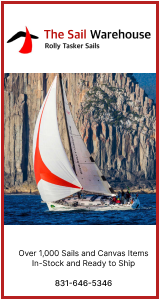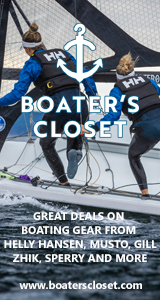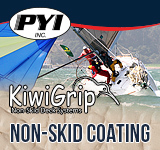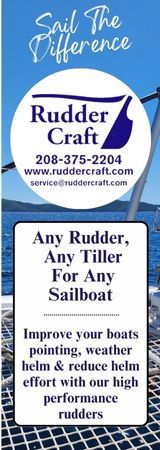Forum Replies Created
-
AuthorPosts
-
 PaulKParticipant
PaulKParticipantFixing a leaky keel/hull joint is a major endeavor. Such leaks are frequently caused by the keel hitting something underwater. The forces involved often jam the back end of the keel up, damaging the hull there, and levering the front of the keel down, opening up the seam between the keel and hull and often damaging the hull or floors (ribs) that the keel is attached to. A proper repair usually calls for removing the keel from the hull, repairing the hull where it has been damaged, and then re-seating the keel to the hull. Getting the keel off will be essentially impossible if you are planning to beach the boat at high tide and prop it up on the shore. Taking the keel off will remove the main support that is holding the hull up. The stands that would be simply holding the boat balanced on its keel will need to actually support the hull. You would need to dig a hole under the keel so it could separate from the hull. The stands would tend to sink into the shoreline mud as the tides came and went – making the entire structure unsteady and prone to falling over.
It might be possible to do a “quick and dirty” fix by simply wrapping or covering the entire hull/keel joint with fiberglass and epoxy. This might stop the leak temporarily. But, if the keel/hull joint is damaged from a grounding, the keelbolts may not be holding the keel firmly. When the boat is refloated every wave that hits the hull will cause the keel to swing from side to side a little bit, like a pendulum. The keel on this boat weighs more than a ton; an epoxy/fiberglass band-aid wrapped around the keel/hull joint is not going to keep it from moving. The movement will end up breaking the epoxy/fiberglass joint. The leak will return and if not repaired properly the constant flexing could end up weakening the keelbolts enough that they break, and the keel falls off. This is why people with leaking keel/hull joints remove and re-attach their keels.
This boat does not appear to be a good low-cost housing option.
 PaulKParticipant
PaulKParticipantIt could be that the Atlantic dinghy simply used a Dyer Dhow rig. They would have been available and perhaps less expensive than designing and building a separate rig for a similar dinghy that was less well-known.
 PaulKParticipant
PaulKParticipantAccording to the plan profile here: https://sailboatdata.com/sailboat/southerly-115/ the cabintop height above the waterline is about 1.8m . The mast would probably go up on horses above the cabintop. How high that is would determine which bridges you could get under. A lot depends upon which canals you intend to take. The lowest bridge on the Canal du Midi is reputedly one in Carcassonne. (see insert). Water levels can change the clearances dramatically, sometimes closing canals due to either drought or too much rain. The Southerly 115 with its lifting keel looks like a good candidate for the canals in any case.
Attachments:
You must be logged in to view attached files. PaulKParticipant
PaulKParticipantThis generally reputable site https://sailboatdata.com/sailboat/yorktown-35/
says that it’s 27 gallons.
 PaulKParticipant
PaulKParticipantUsually on the transom, starboard side, just under the hull/deck joint. Your Ranger 26 may have been built before they were required in 1972.
 PaulKParticipant
PaulKParticipantWhat about them? You have some to sell? You’re looking for some? You need to know how long they’re supposed to be …?
 PaulKParticipant
PaulKParticipantIf it is Documented with the USCG you may get some information there. Otherwise it depends on state registration records which may be harder to access.
 PaulKParticipant
PaulKParticipantThere isn’t much information online about these boats. The long keel suggests that ballast may be internal. If it is, and if it is steel or iron punchings in a matrix, beware. Any leak or water ingress into the ballast sections of the keel will cause it to rust. Rusting causes the steel or iron to expand. This can blow the keel open and lead to the ballast falling out. If the ballast is lead or if it is externally mounted there is less to worry about.
 PaulKParticipant
PaulKParticipantLooks like a comfy cruiser. Where are you sailing?
 PaulKParticipant
PaulKParticipantGoogle is your friend: https://www.google.com/search?client=safari&rls=en&q=transom+ladders&ie=UTF-8&oe=UTF-8
We replaced ours with a telescoping one that fits flat on our sugar-scoop, but flips down and extends. It can be deployed by someone in the water, if necessary. Much better looking and safer than the folding unit that was fastened up at the taffrail.-
This reply was modified 5 months, 4 weeks ago by
 PaulK.
PaulK.
 PaulKParticipant
PaulKParticipantMuch prettier than the center cockpit version.
 PaulKParticipant
PaulKParticipantWhat are they near to? Where do their hoses go? Checking the condition of the hoses and their hose clamps (two on each end of each hose!) is an important part of your inspection, so you need to look. The small one is likely the engine cooling water intake. Three others are likely for the galley sink, head sink, and head. Can’t guess about the other one.
October 25, 2023 at 1:40 pm in reply to: SQL like query on database? Where (LOA – LWL) < 5 feet #89857 PaulKParticipant
PaulKParticipant“Comfort level” is sort of like an equation that tells you that a Lamborghini TestaRossa is equivalent to a Cadillac Seville because they both have big leather seats. Not really useful.
October 24, 2023 at 9:47 pm in reply to: SQL like query on database? Where (LOA – LWL) < 5 feet #89852 PaulKParticipant
PaulKParticipantThe best way to get this information quickly might be to perform a search that includes as many of the options as can be made at once and then do another one or two including the other criteria. You will still end up with too many boats to actually be useful, not to mention that the “comfort level” criterion is not especially valid.(It’s a calculated figure that gets warped as different hull styles come in and out of fashion.)
If you’re looking for a boat it makes more sense to see what there is for sale. . There’s no point in doing hours of investigation into hundreds of designs in order to learn that the Sealark 38 is the optimal boat for your needs and then find out that only three of them were built in 1980 at a shipyard in Croatia. Weeks more research and you could learn that one of them was run down off Bari on her maiden voyage by a Panamanian-flagged tanker, the second sank after hitting a rock off Dubrovnik in 1994. That the third is for sale in Sevastopol for 3,000 rubles and probably needs 600,000 rubles of work done to be made seaworthy again is not going to help you. PaulKParticipant
PaulKParticipantChanging the designed rig from fractional to masthead would probably not be a good idea. It would be expensive to get and install a new forestay, add a new sheave and buy a new jib. It might very well mess up the balance of the boat too, making it harder to handle and not necessarily faster. It would certainly reduce any resale value. Van de Stadt is known for well-designed and built boats.
To improve downwind speed some people do rig a masthead spinnaker on their fractionally-rigged boats, which is much simpler to do. You would need to rivet or bolt a pulley at the top of the mast, run a spinnaker halyard through it and find a suitably sized spinnaker to hoist on it. The mast might not be up to the force of the new sail, however; a strong breeze might turn the mast into a pretzel. We had a fractionally rigged J/36 and contemplated this, since some of them in Oregon have done it. Our smaller, more managable spinnaker allowed us to pass a J/35 on a downwind leg in a windy race, however, while they broached, so we decided not to change. -
This reply was modified 5 months, 4 weeks ago by
-
AuthorPosts












